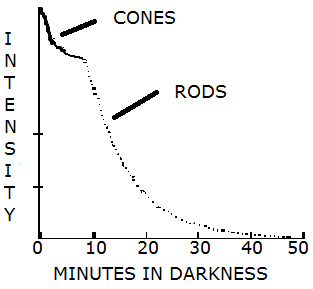dark adaptation

Visual response to darkness. Cones work at high light levels; rods take over at twilight and night. The y-axis has logarithmic scaling.
Dark adaptation is heightened sensitivity to light when the eye is subjected to darkness for an extended period. Chemical changes take place in the retina, mostly in the first 20 minutes in darkness but continuing for up to two hours, that greatly improve the observer's ability to see faint objects. However, they can be cancelled quickly by a sudden exposure to light, which is why amateur astronomers carry red-filtered flashlights into the field for use for reading star charts, setting circles, and telescope controls.


